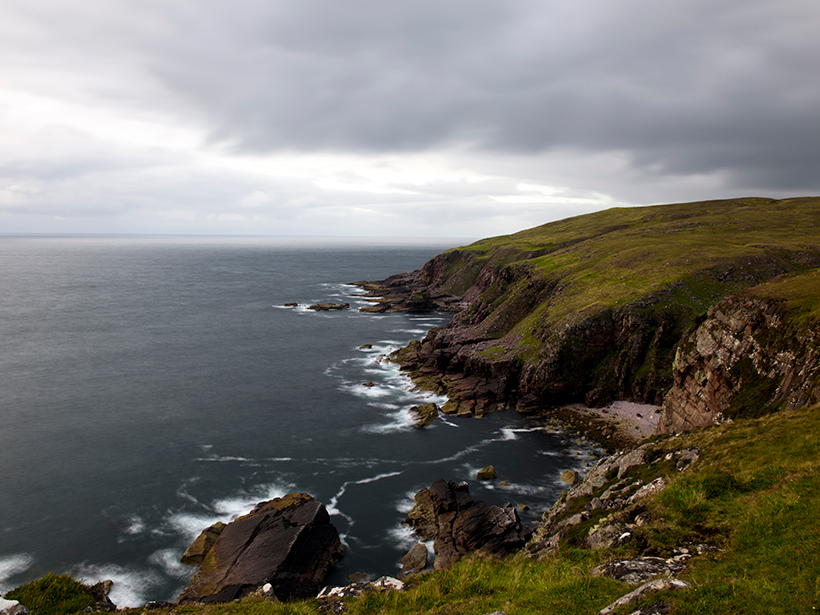Great Britain’s largest impact crater remains bafflingly hidden, despite continued investigation. The only clue comes from a blanket of material blown up by the impact 1.2 billion years ago, then rapidly covered by sediment.
Two geologists have staked their claims for the crater’s location—in opposite directions from leftover traces of the impact.
Along the northwest coast of Scotland, the Stac Fada Member deposits were long thought to have come from a volcano. Although the formation had been explored by scientists for well over a century, it wasn’t until 2006 that Ken Amor, then a Ph.D. student at the University of Oxford, found bits of shocked quartz that confirmed the site had formed when a space rock slammed into Earth.
“It’s not terribly surprising that they come to different conclusions. It’s an interesting and good mystery.”
Now a geologist at Oxford, Amor has released a new paper with a more in-depth analysis of the region. Amor and his coauthors set the missing crater about 20 kilometers offshore, in the Minch channel that separates the Outer Hebrides from the northwest coast of mainland Scotland.
At the same time, Michael Simms, a geologist at National Museums Northern Ireland, has also published a paper expanding on his own previous research into the site of the impact. Simms suggests the missing crater is 50 kilometers east of the Stac Fada Member outcrop, beneath the town of Lairg, Scotland.

The contrasting conclusions shouldn’t be a surprise.
“They’re very different data sets,” says meteorite impact expert Jay Melosh, a geophysicist at Purdue University in Indiana who was not part of the research. “It’s not terribly surprising that they come to different conclusions. It’s an interesting and good mystery.”
Two Theories, No Craters
When a meteorite slams into the ground, it blasts a cloud of pulverized rock, hot gas, and molten material into the air. Heated gases lift the debris up, rapidly carrying it away from the impact site. Clouds of boiling gas and dust reach several hundred meters into the air. As they travel, they leave a trail of debris that can be traced back to the crater—but only if you’re fast enough.
On Earth, erosion and plate tectonics rapidly erode and cover these ejecta blankets. Most are gone in a few tens of millions of years, according to Melosh. Of the nearly 200 impact structures known to exist on our planet, only a handful of intact ejecta layers have survived. With so few Earth-bound examples, interpreting the details of the impact remains challenging.
Amor analyzed the magnetic minerals found inside the rocks themselves to determine how they arrived at their current location. The technique, well used in geology for determining the paths of ancient rivers and volcanic flows, has never before been used to determine the flow of an impact. Amor and his team sampled four locations and found they pointed toward a western source.
Simms took a different approach. In a 2015 paper, he examined the region around the ejecta and found a 40-kilometer-wide gravitational anomaly, the Lairg Gravity Low, that could be a crater remnant. Similar observations have been seen around other impact craters. After a meteor slams into Earth, the resulting crater soon fills with lighter material, leaving a less dense region. There’s just one problem: The supposed crater is buried beneath kilometers of this less dense debris.
In his new research, Simms worked with impact specialist Kord Ernstson of the University of Würzburg in Germany. Ernstson realized that the Scottish anomaly showed no sign of a central peak common to craters of similar size.
“It was a bit of an enigma,” Simms says.
Reconsidering Crater Size
But what if the anomaly itself was the central ring, with the larger crater rim eroded away? If so, the original crater would have been twice as large as suspected, nearly 100 kilometers across.
The proposed new crater size raised new problems. Something large enough to excavate an enormous crater would have dropped a thicker ejecta blanket.
But Earth’s crust is in constant motion. Lairg lies near the Moine Thrust Belt, a series of faults and upwellings that has changed the crust of the Scottish Highlands. Previous observations of the thrust suggest that the crust has moved significantly over hundreds of millions of years, and Simms reasoned that the shifting crust could have moved the crater anywhere from 40 to 60 kilometers closer to its ejecta blanket at Stac Fada.
“That is feasible given where [the supposed crater] is situated,” says Gordon Osinski, an impact crater specialist at Western University in London, Ontario, Canada.
“Basically, both papers are actually talking about some of the very same observations, but interpreting them differently. That is geology to a T.”
Amor remains skeptical. Moving the crater farther east would have put the original impact in the ocean, and the ejecta should have contained marine sediment, none of which is found at Stac Fada. He also points to geologic observations of the region made nearly 3 decades ago, which call the similarity between the muddy sandstone of the ejecta blanket and the massive siltstones beneath them “remarkable.” The resemblance suggests that the ground beneath the impact crater was fairly similar, and thus fairly close, to the debris blanket.
“The impact debris therefore gives clues as the provenance of where the impact occurred,” Amor says.
Basing observations on the fortuitous location of a gravitational anomaly can be a bit tricky as well.
“Everybody knows gravity is inherently ambiguous,” Melosh says.
Even when they approach the ejecta the same way, the researchers disagree. Both teams looked at wedges of impact debris pushed along some of the layers of preexisting sandstone. The moving pressure wall would have pushed the ejecta against the existing rocks. However, whereas Simms interprets the wedges as having been pushed from east to west, Amor views them as having been pushed from west to east, resulting in predicted craters that lie in opposite directions.
“Basically, both papers are actually talking about some of the very same observations, but interpreting them differently,” says Osinski. “That is geology to a T.”
Crater Hunting
Determining which location is the site of Great Britain’s largest impact crater may take a bit more digging—literally.
The best way to tell whether a crater formed from a meteorite impact is to take a core sample. After drilling through material that settled over the crater during the past 1.2 billion years, geologists would hit the sludgy sediments that filled in the young impact. Beneath that should lie a thick sheet of rock melted by impact and then resolidified. A layer of fractured rock where the subsurface shattered from the impact filled in by melted rock would stretch for several kilometers under the melted rock.
“Even if the crater had been seriously eroded billions of years ago, you would still find evidence of fracturing,” Simms says.
Drilling into Simms’s gravitational anomaly would be a substantial and costly undertaking because the anomaly itself is buried by kilometers of rock. Amor’s crater might be a bit easier to probe—assuming it can be found.
Right now, Amor is poring over seismic reflection profiles conducted by oil companies around the United Kingdom in the 1970s and 1980s. Unfortunately, they aren’t the highest quality, but he says they remain the best hopes at present for direct evidence of an underwater crater.
Even better would be modern 3-D seismic observations, which could produce images of the remnants of the impact crater. “There should be something there,” Amor says.
The relatively easy access makes Amor’s theory more testable, according to Osinski.
Simms is also looking for another way to probe the ground beneath Laird. He’s hoping that he or another scientist might get the funding to do a more highly detailed gravitational survey, as the existing data are “a bit old.”
As for Osinski, he’s reserving judgment about which interpretation fits best until he can return to the site and take another look at the blocks with both perspectives in mind. He hopes Simms and Amor will do the same.
“I would hope these authors will go back and take a look at each other’s data,” he says.
And it’s entirely possible neither interpretation is correct.
“Maybe they’re both wrong, and there’s a third idea out there somewhere that people haven’t thought of yet,” Osinski says.
—Nola Taylor Redd (@NolaTRedd), Science Journalist
Citation:
Redd, N. T. (2019), The search for the impact that cratered ancient Scotland, Eos, 100, https://doi.org/10.1029/2019EO127543. Published on 12 July 2019.
Text © 2019. The authors. CC BY-NC-ND 3.0
Except where otherwise noted, images are subject to copyright. Any reuse without express permission from the copyright owner is prohibited.

